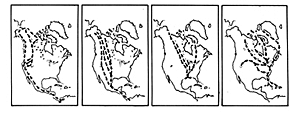Migration |
||
|---|---|---|
|
The arrival of birds in the spring and their disappearance at the end of the breeding season is one of the most familiar aspects of North American bird biology. Seasonal migration enables birds to avoid the physiological stresses of unfavorable climates and to exploit food supplies that are available for only limited periods each year. Thus, many species can breed at high latitudes during the brief but insect-rich arctic summer, and then fly south to the more hospitable climate of the southern United | |
| States, Central
America, of South America. While we may think of them as
"our" birds that go south for the winter, it may be more
logical to think of them as southern species that make a
relatively brief foray north to breed. Seasonal migration
presumably evolved as a means of increasing lifetime
reproductive output. It permits exploitation of areas that
either are more productive or provide less competition than
the wintering grounds. Moreover, daylight periods in spring
and summer are longer at higher latitudes, resulting in more
hours per day in which birds can gather food. Preparation for migration involves both physiological and behavioral changes. Physiological preparation includes the accumulation of fat to provide fuel for prolonged flight. Not uncommonly, passerines lose one-fourth to one-half of their body weight during overwater migration. Behavioral changes are especially prominent in nocturnal migrants, which alter their activity rhythms during darkness and begin to preferentially orient in the direction that they will soon be flying. Most long-distance migrants, especially smaller birds, fly at night; they may travel continuously or land daily around sunrise to rest and forage. When traveling over water or unsuitable habitats, birds that normally stop each day may fly without a break for longer periods. For example, Blackpoll Warblers migrate overland in spring, but autumn migrants travel nonstop over open ocean from southeastern Canada and the northeastern United States to their wintering grounds in northern South America. Migrants that move only relatively short distances within our region usually travel during the day, generally spending only a few hours of the morning in migration. Aerial foragers, such as swallows and swifts, do not stop but simply feed in flight as they are migrating. Migration in North America is essentially north-south along four principal routes or "flyways"; Pacific, Central, Mississippi, and Atlantic. In Europe and Asia, some migration routes are oriented more east-west, although latitudinal change is still significant. About 150 species of land and freshwater birds that breed in our region winter to the south in Central and South America and the West Indies. Different species characteristically migrate different distances between wintering and breeding areas. The Arctic Tern, as its name implies, breeds in the high Arctic, winters near the southern tip of South America and as far south as Antarctica. In contrast, Clark's Nutcracker often migrates only a few miles to move from its high-elevation breeding sites in the Rockies or Sierras to lower elevations within the same mountain ranges. In many bird species, males winter farther north than females or juveniles. Where females are larger than males (as in many birds of prey) or where dominance relationships between the sexes are reversed (as in polyandrous Spotted Sandpipers and phalaropes), females often winter farther north. Three hypotheses have been advanced to explain this phenomenon of differential migration -- males, females, and sometimes different age groups within each sex wintering at different latitudes. The body-size hypothesis suggests that larger birds have greater cold tolerance and enhanced ability to fast through periods of inclement weather, and therefore can better endure the rigors of winter. Hence, smaller individuals should migrate farther south. A second explanation is based on dominance relationships within a species: in general, smaller individuals are subordinate to larger ones and therefore should migrate farther south. Third, the arrival-time hypothesis states that if members of one sex experience more intense competition for breeding resources than the other, then individuals of that sex should benefit by early return to the breeding grounds. This can best be achieved by wintering as close as possible to breeding areas. Because males are larger than females in most migratory species, and because older birds tend to be larger than younger birds, it is often difficult to distinguish among these three hypotheses, which obviously are not mutually exclusive. Just as many species show strong fidelity to breeding sites to which they return each year to nest, many migrants show some degree of site fidelity to wintering areas. Recent studies of Yellow-rumped Warblers, however, indicate much greater plasticity in choice of wintering site than previously thought. Ornithologists Scott Terrill and Robert Ohmart found that warblers wintering in desert riparian habitats shifted to similar but more southerly habitats in response to changing climatic conditions that led to a scarcity of their insect prey. These observations suggest that birds maintain a physiological readiness to continue their migration in a properly oriented direction well into the winter months. How widespread this ability is among migratory species remains to be determined. |
||
| SEE:
Navigation and Orientation;
Breeding Season;
Site Tenacity;
Irruptions;
Wintering and Conservation. Copyright ® 1988 by Paul R. Ehrlich, David S. Dobkin, and Darryl Wheye. |
||
